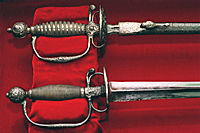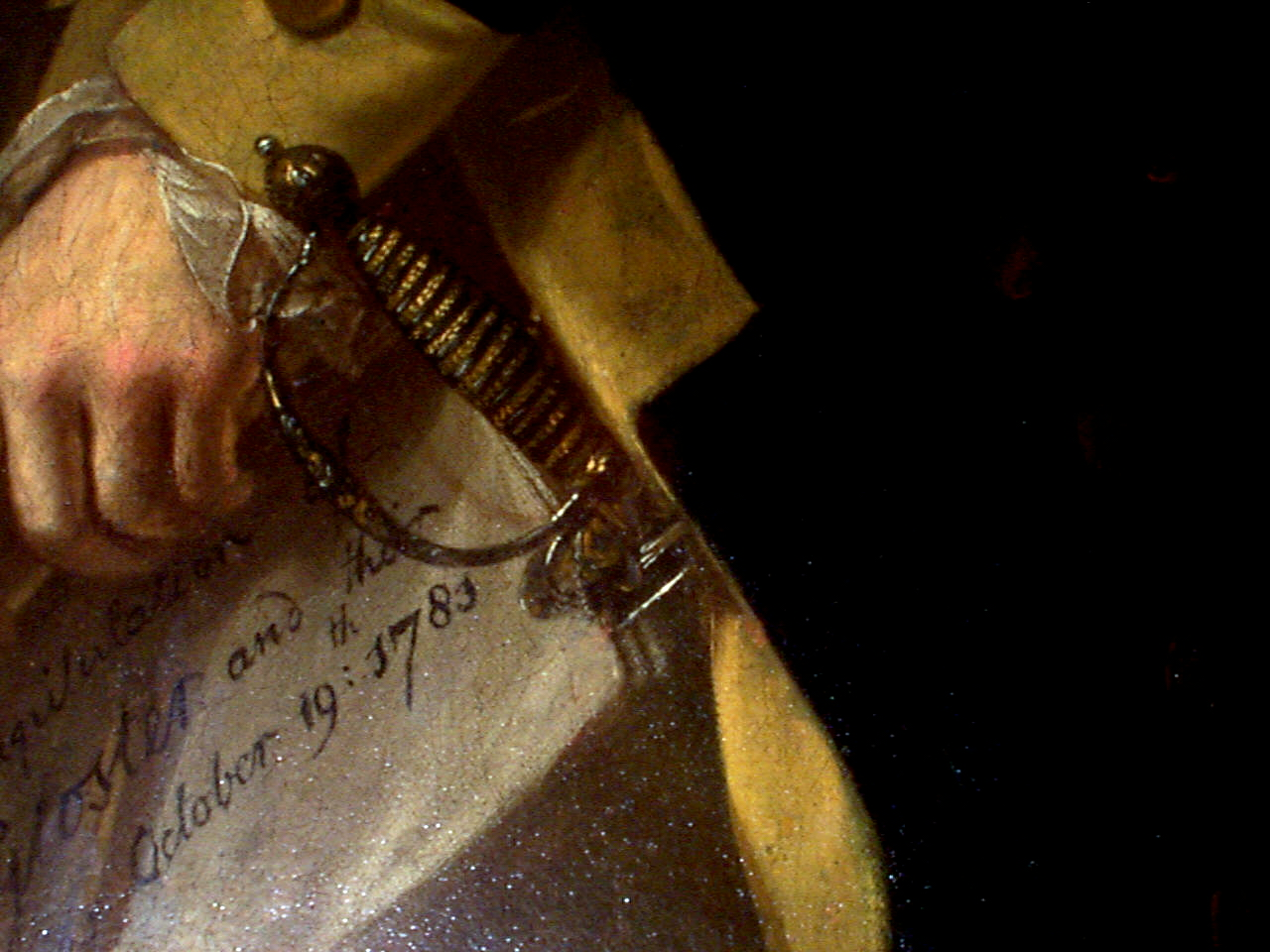
President Miller, members of the Senate, Governor Glendening, Treasurer Dixon, Comptroller Goldstein, ladies and gentlemen
Tonight we are about to unveil a new exhibit in this room, the first since 1983 when, with the generous support of Senate's Past, we placed the life-like representation of Washington in his uniform there on the spot where he resigned his commission as Commander-in-Chief, and temporarily borrowed the actual commission from the Library of Congress for display nearby. In unveiling this new exhibit fifteen years later, we pay tribute to one of Maryland's most distinguished soldier-citizens of the Revolutionary War, Tench Tilghman and to the man he served so well, George Washington..
On December 26 of last Year, Mrs. Judith Oates passed away, leaving the state the two swords you are about to see.

She intended them as a permanent memorial to her direct ancestor, Tench Tilghman. She instructed that they be displayed near his portrait here in the Old Senate Chamber.
Through the efforts of Comptroller Goldstein, General Orwin Talbott, then Governor Harry Hughes, and former Treasurer William S. James, the state had expressed a genuine interest in the swords in the late 1970s, offering to purchase them for exhibit in the State House. Mrs. Oates preferred to keep them, feeling that they were worth more than the state was able to offer, but at the urging of a friend, Cecil Bishop, who was helping her plan her estate, and with encouragement from people like Joe Coale, she decided to give them to the state in her will.
I suspect that Nancy German was quite surprised to find, when she called on President Miller's behalf for any suggestions we might have for tonight, that we would suggest a major exhibit and would ask for the Senate's help in carrying out Mrs. Oates wishes. Nancy, whose tasteful handling of these ceremonies every year brings special meaning to being a member of the Maryland Senate, checked with the President and then asked us to proceed. Once Governor Glendening had given his approval of the acceptance of the gift, a case was designed and built by Rob MacAdam of the Archives' staff, under the close supervision and direction of Mimi Calver and with the assistance of Carol Borchert. To preserve the swords properly we consulted with leading conservation authorities, including our own Hanna Szcezepanowska, and used the opportunity to install a state-of-the-art security system to prevent any unauthorized removals. After tonight, when the alarm is set, the slightest motion near the painting or the swords will alert security to the intrusion.
That the swords you are about to see were Tench Tilghman's and that he wore them as aide-de-camp to George Washington from the dark days of Valley Forge to victory at Yorktown, is confirmed by the magnificent portrait of Washington, Lafayette and Tilghman at Yorktown that hangs here over the fireplace. Completed and installed in 1785, this life-sized painting by Charles Willson Peale depicts in easily recognizable detail the hilt of the dress sword.

Next to the sword in the painting are the official dispatches that Tench Tilghman, carried to Congress in Philadelphia, following the defeat of the British at Yorktown on October 19, 1781. Tilghman's journey took him first to Annapolis where, wearing this sword, he informed Governor Thomas Sim Lee of the British defeat. Lee had already heard the news informally from the French and had dispatched the State House messenger and janitor, Jonathan Parker, with the unofficial news.
Philadelphia, used to rumors and wary of celebrating too soon, waited anxiously for the official dispatches Tilghman carried. He took the ferry to Rock Hall, stopped briefly to rest and see his family, and continued on his journey to Philadelphia where he arrived in the wee small hours of the morning of the 24th. Five days after he began his ride, Tilghman first delivered the news to the President of Congress, Thomas McKean. That afternoon, in full uniform and wearing his dress sword, he delivered his dispatches to Congress and answered questions about the battle. In appreciation of his service, Congress would later vote him a horse and another sword.
That night a torchlight celebration was held in Philadelphia in honor of
Colonel Tilghman and the British defeat. "those citizens who
chuse to ILLUMINATE on the Glorious Occasion, will do it this evening at
Six, and extinguish their lights at Nine o'clock," reads the broadside
calling for the parade, adding that
Over the mantle you see the Peale portrait containing the detail of the sword Tench Tilghman wore at Valley Forge, at Yorktown, in this State House, and before Congress in Philadelphia. In the Maryland State Archives is the inventory of the estate taken at Tench Tilghman's death that proudly lists both swords and valuing the Dress Sword at over 3 pounds, twice the usual amount for such a sword. Indeed, according to one appraiser who has examined both swords, the sword in the painting is so rare with its gold inlay that he has never seen another like it, for sale, in a private collection, or on public display. We are indeed most grateful to Mrs. Oates for her gift.
Let us now unveil the swords themselves, uniting them with the only known portrait from life of their owner, Tench Tilghman, who stands there proudly with his close colleague Lafayette, and his Commander-in-Chief George Washington, whose birthday we also celebrate tonight.